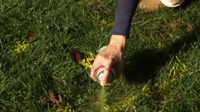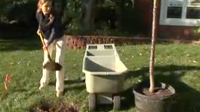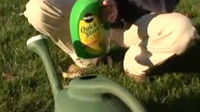You don't the permission to view this video
This video will teach you about the basics of planting a tree. You’ll learn how to select the right tree for the right spot in your yard, you’ll learn some precautionary measures to take before you start digging, and you’ll learn how to care for your tree and make sure it gets off to a good start.
So you’ve decided to plant a tree in your yard. Congratulations! It’s a decision that will enhance your home’s curb appeal for years to come. After all your research in deciding what type of tree to plant, and where to put it, now it’s finally time to grab a shovel and turn some soil. Let the fun begin.
Today we’re going to teach you about the basics of planting a tree. You’ll learn how to select the right tree for the right spot in your yard, you’ll learn some precautionary measures to take before you start digging, and you’ll learn how to care for your tree and make sure it gets off to a good start. So let’s get started.
Before we made the trip to our local independent home improvement retailer to pick out a tree in the garden center, we did some homework to decide on the type of tree we wanted and where to place it in our yard. We chose a location that wouldn’t interfere with the house or any overhead power lines, and that wouldn’t violate any setback requirements or local zoning lawn. For our location, we will be safely away from the house and the sidewalk. The location we picked will also be in full sun for much of the day, which is a requirement for the type of tree we’re selecting, a Kwanzan Cherry.
The great thing about purchasing the tree at our local independent home improvement retailer is they source trees from local growers who know the types of trees that will do well in our region of the country. If you’re unsure if a specific type of tree is suitable for your growing region, be sure and check with your local retailer first.
The last thing we need to do before we start planting is to call the local utilities before we dig to check for buried cables. It’s a good thing we did, because the place we were going to plant the tree was just several feet away from the gas line, which is marked with yellow flags. We’ll need to move the tree about 10 feet away for precautionary measures.
There, that should do it. In addition to being clear of the gas line, we also made sure we were clear of any phone lines or buried cable television lines, which are indicated by these red flags, marked “OK”. Now we’re ready to turn some earth.
But before we do, we first need to measure the tree’s container to determine how big and how deep the hole needs to be. The planting instructions that came with the tree indicate that we need to make the hole 6” wider than the diameter or the container. It also says we shouldn’t make the hole any deeper than the depth of the container. Looks like our container is 18” in diameter and 15” deep. That means our hole needs to be 24” in diameter, which we’ll mark with this spray paint.
With the size of the hole properly marked, now we can use our shovel to cut through the sod around our mark. When complete, we can remove the sod and discard it, exposing the soil. Either this long-handle or this D-Handle round-point shovel will do the trick. In this case, the longer handle will give us more leverage turning the hard clay soil in our yard. Next, we will remove the soil to a depth of 15” and place it in our garden cart to use as backfill.
After moving our tree into position, we will tip it over to remove the container. Then we’ll loosen the roots slightly so they aren’t matted. This will help encourage root expansion and growth after the tree is planted. Just one more check to make sure the depth of our hole is the same as the depth of the soil at the top of the container. Laying a piece of wood across the hole will help you measure precisely.
Now, with the help of a friend, we’ll set the tree in the hole and try to make sure it’s as level as possible. This level will help. If it’s not, we can strategically backfill dirt under certain sides of the root ball to help level the trunk.
Before we backfill the soil, we’ll add some plant food for trees to the backfill dirt in the garden cart. Then we’ll backfill the hole, making sure we don’t cover the root ball with any soil.
In a watering can, we’ll also add some root stimulator to help prevent transplant shock and encourage new root growth. We’ll mix this with water according to the manufacturer’s instructions.
Next, we’ll water the tree in thoroughly, and we’ll continue to water it on a regular basis for the first few months, which is vital to the tree’s health. New trees like ours need at least 1” of water per week, whether it’s by irrigation or by rain. An ideal way to water a tree with a 1-1/2” diameter trunk is to turn the hose on to a trickle and let it soak it for 20 to 25 minutes. Remember, a slow soaking is much better than a quick hose down. For tips on watering and signs of over-watering see our Frequently Asked Questions for this video. A general rule of thumb to know whether or not a tree needs watering is to dig 4” deep somewhere around the root ball. If the soil is dry at this depth, the tree needs water. If it’s wet, it doesn’t.
Now it’s time to stake and mulch around the tree. Staking the tree for the first full year after planting will help it grow healthy and straight, and will prevent it from getting damaged by the wind. Follow the manufacturer’s instructions carefully. When the tree is staked, spread mulch around the base of the tree, making sure it’s 2” to 3” deep. But be sure to keep the mulch at least 2” away from the base of the truck, which could cause disease.
So there you have it. Years from now, when the tree is fully grown and in its full glory, you can tell everyone how you selected the site, turned the soil and planted this tree yourself. And all it took was the right tree, the right products, and some good advice from your local independent home improvement retailer.
Steps
- 1.

Research, research, research! Determine the right tree based on the amount of sunlight it will receive daily. Call the local utilities to check for underground wires and plumbing.
- 2.

Your tree should come with planting instructions to see how wide and deep the hole in the ground needs to be. Spray a line to help you.
- 3.

Dig the hole using a shovel that's right for the job. We used a D-Handle round-point shovel. Place excess dirt in a wheelbarrow. We will be using this dirt later.
- 4.

Move the tree into position near the hole. Tip it sideways and remove the container.
- 5.

Loosen the roots slightly with a hand cultivator to encourage root expansion and growth.
- 6.

Place the tree into the hole keeping it level. It's it's leaning too much, strategically add some dirt on the problem side below the roots.
- 7.

Add some tree food to the excess dirt from the hole. Mix it up and fill up the hole.
- 8.

Add root stimulator to some water in a watering can.
- 9.

Water the tree thoroughly and frequently for at least a month. New trees need at least 1 inch of water per week.
- 10.

One way to check for soil dampness is to dig a 4 inches deep near the root ball. If the soil is dry, then the tree needs water.
- 11.

Add mulch on top. About 2 inches thick will be enough. Keep it 2 inches away from the tree trunk to prevent disease.
- 12.

Stake the tree for about a year will keep it healthy and straight, as well as protect from wind damage.




Comments (0)